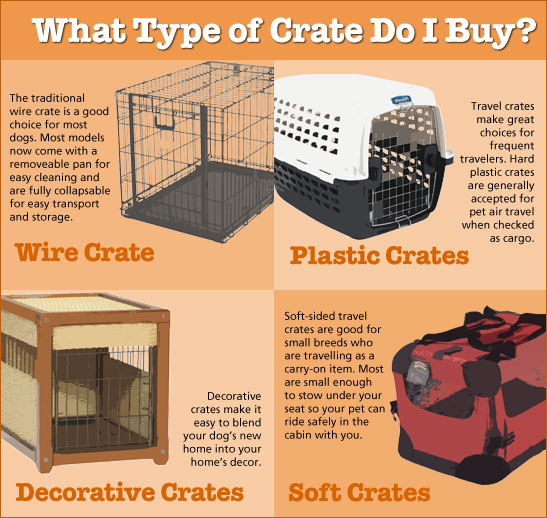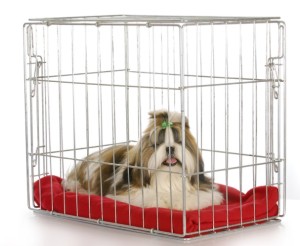So you’ve decided to start crate training your dog. Congratulations! You’ve taken the first step towards creating a safe haven in your home where your dog can have a place to rest and feel safe during uncertain times or when they are unsupervised.
The first obvious step to crate training is to purchase a dog crate, however there are so many choices on the market, where do you start? The first thing you’ll want to consider is the adult size of your dog. Sometimes you won’t know the adult size of your dog, say if you have adopted a mutt. In this case you’ll have to make your best guess at the adult size you think your dog will grow to be (I’ve been wrong all three times, good luck!). If you have a purebred, they’re all generally the same size range, so choosing the right size crate is simpler.
Choose a crate that will be large enough for your dog to stand up straight, circle around inside, and stretch out comfortably inside once they are an adult:
 Here’s a handy guide, but it is intended as just that (a guide) your dog may require a crate that is larger or smaller than what is listed here.
Here’s a handy guide, but it is intended as just that (a guide) your dog may require a crate that is larger or smaller than what is listed here.
Extra Small: 18 – 22 inch crates are generally appropriate for extra small or toy breeds such as Yorkshire Terriers, Maltese, Papillons and other toys breeds.
Small 24 inch crates are generally appropriate for small dogs like Pugs, Shih Tzus, Miniature Dachshunds and other small breed dogs.
Medium 30 inch crates are appropriate for medium-sized breeds like French Bulldogs, Dachshunds, Scottish Terriers and other medium breed dogs.
36 inch intermediate sized crates are appropriate for dogs like Bulldogs, Bull Terriers, Beagles, Cattle dogs, Border Collies and similar breeds.
42 inch large crates are appropriate for large breeds such as Boxers, Collies, Dalmatians, Poodles, Retrievers and similar dog breeds.
Extra large crates, size 48 inches or larger, are meant for dog breeds like Akitas, Rottweilers, Huskies, Malamutes and other giant breed dogs.
 Once you’ve determined the size crate you need to buy you need to consider the type of crate suits your lifestyle. If you have a small breed dog and you’re often on the go or travelling, you may want to consider a soft travel carrier or crate. These generally only come in sizes large enough for small dogs who are able to travel in the cabin of an aircraft under the seats.
Once you’ve determined the size crate you need to buy you need to consider the type of crate suits your lifestyle. If you have a small breed dog and you’re often on the go or travelling, you may want to consider a soft travel carrier or crate. These generally only come in sizes large enough for small dogs who are able to travel in the cabin of an aircraft under the seats.
If you’re an avid traveller and wish to travel with your dog who is a larger size dog, you’ll need to purchase a hard plastic kennel that is airline approved for use in the luggage compartment of the aircraft. Check with your airline for the specific specifications that your airline requires. Plastic travel crates are also great for frequent car travel trips, if you prefer to vacation via road trip with the whole family.
For crates of any size that will be permanent fixtures in your home you could use a plastic travel kennel which come in multiple sizes from small to extra large and a variety of colors, a standard wire crate, or a decorative crate. Standard wire crates come in multiple styles. Some have garage-style doors, others have one or two doors so you can choose which side is the opening side, and almost all of them are easily collapsible and easy to set up in just minutes. These are the most common types of crates you’ll find in most homes.
A newer introduction to the selection of crates available are decorative crates that look like furniture in your home. While commonly much more expensive than a standard wire crate, if you plan to use your dogs crate for the life of your pet (which is how a crate should be used, as your pet’s forever den) these can be a very nice investment to make. They’re very nice home accents and don’t disrupt the look of your home.
 Earlier I instructed that the size crate should be the size needed for your dog as an adult. Many people know that if you put a puppy in a crate that is too large that potty training using a crate isn’t going to be successful because they’ll use one side as a bathroom and the other side for sleeping. Most crates now come with an adjustable divider panel that allows you to reduce the size of your crate and adjust it as they grow in to it, saving you money so you don’t need to buy larger and larger crates over time. This is a great improvement that they’ve added in the last few years. When I trained my dogs as pups I used towels and blankets to make the crate smaller, which needed lots of washing when there were accidents!
Earlier I instructed that the size crate should be the size needed for your dog as an adult. Many people know that if you put a puppy in a crate that is too large that potty training using a crate isn’t going to be successful because they’ll use one side as a bathroom and the other side for sleeping. Most crates now come with an adjustable divider panel that allows you to reduce the size of your crate and adjust it as they grow in to it, saving you money so you don’t need to buy larger and larger crates over time. This is a great improvement that they’ve added in the last few years. When I trained my dogs as pups I used towels and blankets to make the crate smaller, which needed lots of washing when there were accidents!
Hopefully now you have a good idea of the types of crates available and which type and size crate will be best for your dog and for your lifestyle. Invest money now in a good crate and it will last you for years to come, if you put the time and effort into crate training you won’t regret spending a little extra. Good luck on your crate training adventures!
 That Pet Blog That Pet Place Pet Blog
That Pet Blog That Pet Place Pet Blog

Used crates for a while now, always found it helped with training. I still use them for my older dogs!